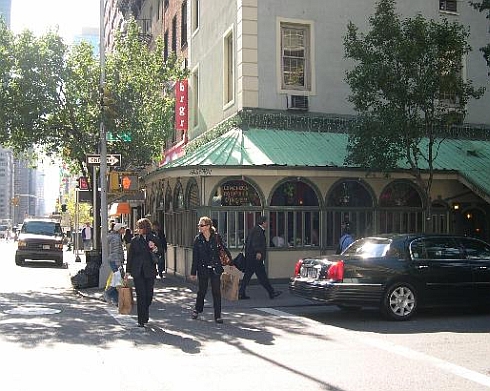Category Archives: 60s New York
The record that introduced the voice of Astrud Gilberto
The last icon of my New York City childhood is not a visual icon but a vocal one. Astrud Gilberto, a young Brazilian woman, came to the United States in the early sixties with her husband the guitarist Joao Gilberto and legendary songwriter, arranger and bossa nova stylist Antonio Carlos Jobim at the invitation of sax player Stan Getz to record an album of new jazz samba that would sell millions of copies and become one of the most well known jazz albums of all time and an iconic sound of the 60s. Astrud had never sung professionally but was pressed into service to sing “The Girl From Ipanema” because she was the only one of the Brazilians who could speak English. The low affect of her voice was the perfect counter-point the emotional inflection of her husband’s guitar and Getz’s hushed sexy-voiced saxophone. The record resonated from tropical wood stereo speakers in living rooms lit by the soft green lights of Harmon/Kardon receivers all over America. Astrud became the female voice of the 60s of my mother’s generation — the epitome of cool, adult sophistication. She left Gilberto for Getz in the mid-sixties and continued to record and sing until an unofficial retirement in 2002. Mother saw her in the late 60s in New York and I can still remember falling to sleep on Park Avenue to the clinking of classes, the laughter of grown up conversation and the soft voice of Astrud singing.
“Corcovado”
Eloise
Eloise’s portrait at the Plaza Hotel
In 1955, my publisher Simon & Schuster published one of the greatest, most joyful, most subversive picture books of all time Eloise by Kay Thompson with illustrations by Hillary Knight. Eloise is a six year old girl who lives at the Plaza Hotel in New York City with her Nanny, her pug Weenie and her turtle Skipperdee and she is impossible and wonderful and for the most part on her own in a world made for grown-ups while her parents are always away. For me, it was almost like someone was telling my own story (the good parts at least) and Eloise became part sister, part role model, part best friend.
Kay Thompson (aka Katherine Louise Fink) was born in Missouri (just like me although in St. Louis not Kansas City) and became a singer, arranger, musician, songwriter, actor and, of course, author. She started in radio as a singer and choral arranger and worked with Bing Crosby and later headlined with the Williams Brothers (Andy’s first introduction to the world). She went to work for MGM as a vocal coach and choral director under the legendary musical producer Arthur Freed and worked with Judy Garland, Lena Horne and Frank Sinatra while there. Her only big starring film role was in the Stanley Donan musical Funny Face in which she played the imposing fashion editor, Maggie Prescott for whom Fred Astaire’s photographer and Audrey Hepburn’s model characters work. She was loud and brassy and wonderful — just like a grown up Eloise.
In fact, when asked if her goddaughter Liza Minelli was the model for Eloise, Thompson, the longtime Plaza Hotel resident, famously replied, “I am Eloise.”
While that may have been true, by the time I was introduced to the books while living in the Dakota and having tea at The Plaza and scrounging hors d’ouvres off the coffee table the mornings after Mother’s parties on Park Avenue in the late 60s, I was pretty sure that Eloise was me. And it was a great comfort.
Isle of Capri
Isle of Capri, 3rd Ave. and 61st Street
In addition to the high style and classic French presentation of restaurants like La Grenouille, La Caravelle and Lutece, 1960s New York offered another kind of “fine” dining experience — the clubby neighborhood classic, often a bistro with sidewalk seating. After my mother divorced my step-father and sold the apartment in the Dakota we moved to Park Avenue on the Upper East Side which was home to many of this other type of restaurant, probably because there were fewer people who cooked in this more rarified neighborhood. One of our regular haunts was the Isle of Capri. It was a “fancy” restaurant but run by a family, the Lamanna’s, who made everyone feel as if they were eating at a rich Italian relative’s house. In 1967 Craig Claiborne validated the restaurant’s local reputation by naming it “the best small Italian restaurant in New York” and giving it three stars in the New York Times. It was the kind of place where everyone seemed like a regular and so, for a while, were we. My and Robbie’s La Grenouille training and matching Florence Eiseman dresses made us pretty additions to the crowd and the simple plates of pasta–fettuccine alfredo was our favorite–and veal piccata we were given made us feel happy and at home.
Georgann Rea and RFK
“We had been living in the Dakota, the late nineteenth-century, neo-gothic apartment house at the corner of Seventy-Second Street and Central Park West, for about a year and a half. And while I would later think of the place – the setting for the film “Rosemary’s Baby” and the future and final home of John Lennon – as a glamorous backdrop for my mother’s tumultuous second marriage and divorce, at the time it was just our rather large and wonderfully spooky apartment, in which I was about to find myself awakened by my mother’s rescuers.”
Chanel Bonfire
Our beloved Maudie in the kitchen on Park Avenue…
“The elevator man walked by with another suitcase and our cat, Maudie, in her carrier, yowling like an angry baby. Maudie was a chocolate-point Siamese and always meowed loudly like a person who wouldn’t be ignored.” Chanel Bonfire
Note the unglamorous, pre-Martha Stewart, surroundings. Before the 70s, only cooks and children spent any time in Park Avenue kitchens.







